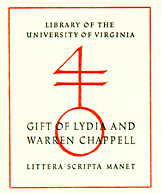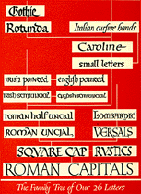Printing, Calligraphy, Wood Engraving, and Book Illustration Collections
The Special Collections Department’s noteworthy holdings in the history of books and printing, which now span the period from the very earliest printers’ manuals to those of the 20th century and include the productions of fine private presses as well, have been strengthened in recent years by the acquisitions of the collections of three artists of the book–Warren Chappell, Oscar Ogg, and Willis W. Tompkins.
From April 22 through August 31, 1978, the Rare Book Department presented a major exhibition entitled “Printing, Calligraphy, Wood Engraving, and Book Illustration” to celebrate the presentation of the Chappell, Ogg, and Tompkins Collections to the University Library. These three superb separate collections relating to the book arts came to the Library through the generosity of donors Warren and Lydia Chappell, Mrs. Margaret W. Ogg, and Mr. Willis W. Tompkins.
The books, manuscripts, and printing artifacts displayed from the Warren Chappell Collections were selected to demonstrate Mr. Chappell’s wide-ranging accomplishments in the graphic arts from the 1930’s to the present. The items included many of the several hundred books he has illustrated and designed for Alfred A. Knopf, Little, Brown, Random House, and other publishers; works he has written, such as The Anatomy of Lettering (New York, 1935), A Short History of the Printed Word (New York, 1970), The Living Alphabet (Charlottesville, 1975), which was shown with its original manuscript and designs, corrected galley proofs, and camera-ready copy for the illustrations of letter forms; “Illustration in These United States” and “Tom Sawyer and the Illustrators,” from The Dolphin (1941); examples and specimens of his well-known typefaces, Lydian and Trajanus; three of the popular recent works he has illustrated, A Charles Dickens Christmas (New York, 1976), A Voyage to Laputa (New York,1976) and Moby Dick (New York, 1976), with their original pen-and-ink drawings and designs; and The Ring (New York, 1964), with its original manuscript copy, one of the three books on opera themes for children that Mr. Chappell has collaborated with John Updike to produce.
The selections from the Ogg Collection reflected the career and scholarly calligraphic interests of the late Oscar Ogg, calligrapher and book designer, who was art director and vicepresident and board member of the Book-of-the-Month Club. They included the Aldine press Le Terze rime di Dante (Venice, 1502), the first book in which Aldus used his famous dolphin and anchor as a colophon device; Giovanni Battista Palatino’s Libro nuovo d’imparare a scrivere tutte sorte lettere (Rome,1554), one of the three great Italian writing books of the 16th century; the Opera. . . dell’ordine minore conventuale. . ., of Vespasiano Amphiareo (Venice, 1555); the Idea del buon scrittore, opera prima, of Tomaso Ruinetti (Rome, 1619), said to be the first writing book to demonstrate the art of calligraphic flourishes and figures, using copperplate engravings; England’s Pen-Man: Or, Cocker’s New Copy-Book (London, 1671), by Edward Cocker, renowned for the complexity of his calligraphic designs; the PenMans Paradis both Pleasant and Profitable (London, 1695), by John Seddon; Giuseppe Savant’s Elementi teorico practici per imparare la bella scrittura (Torino, 1807) and Gaetano Giarre’s Raccolta di caratteri Inglesi, Francesi, Italiani, e Tedeschi(Florence, 1811), two 19th-century calligraphic works with instructions for the preparation of pens, proper posture of writing, and proper holding of the pen.
In addition to these, selections from Oscar Ogg’s own writings were included in the 1978 exhibit: The 26 Letters (New York, 1946) in its unbound final pages with its binding proofs and original copy for the frontispiece and examples of subsequent printings; “An Introduction to Letter Forms,” from Liturgical Arts (August 1949), with the original camera-ready copy for the artwork; his Lettering as a Book Art (Brooklyn, 1949); his “A Comparison of Calligraphy and Lettering,” from American Artist (May 1947); and his issue of Design and Paper (No. 11).
The highlight of the books and original works displayed from the Tompkins Collection was the array of some seventy-five elegant original wood engravings and examples of publications of the Ogham Press, Willis Tompkins’ private press, which he named for the Druidic language and alphabets of pre-Christian Ireland. This selection of blocks is from a collection of over 200 which Mr. Tompkins executed for his Ogham Press productions. Mr. Tompkins was involved professionally in printing and publishing from his college years until his retirement. In 1932 he became the New York representative for the William Byrd Press, of Richmond, Virginia, and he moved to Richmond in 1965 to become executive vice-president of the firm. Avocationally his interests were in printing, calligraphy, and wood engraving, which he had studied in New York at the American Institute of Graphic Arts and under Paul Standard, Arnold Bank, and Hans Alexander Mueller. The collection of reference works, monographs, and examples of private press work that he assembled over the years together, with the wood engravings, comprises the Tompkins Collection, including over 1,800 items on the subjects of wood engraving, calligraphy, letter design, practical printing, binding and related book arts.
The holdings of the department in the important areas of the art of the book and typography have expanded greatly over the past few years. Credit for much of this expansion goes to Warren Chappell, who gave us substantial support through his own gifts, as well as through his encouragement of the gifts of others.
This article was adapted from two written originally by Clinton Sisson for the Library Associates’ publication, Chapter & Verse.


